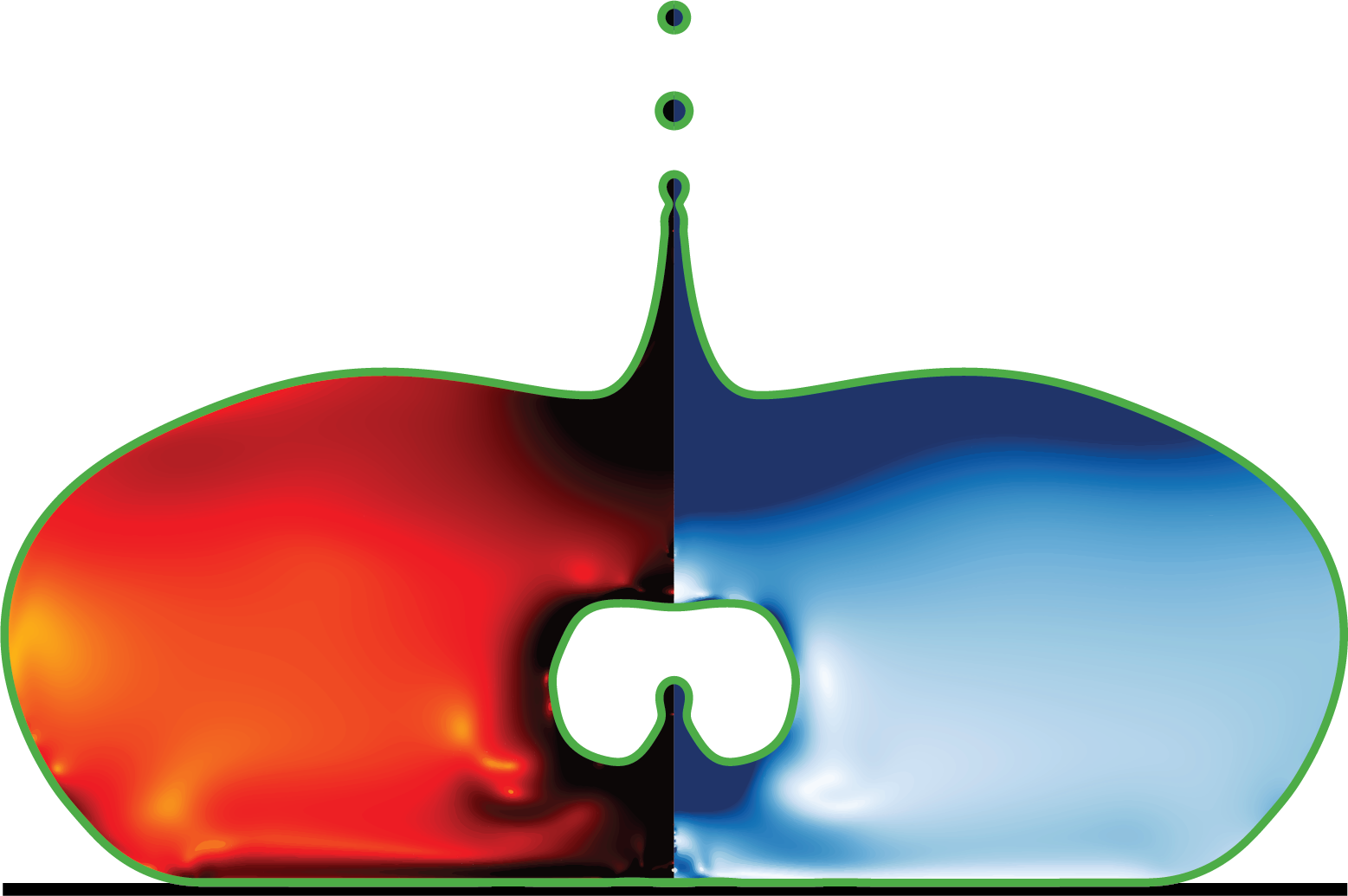src-local/two-phaseVE.h
- Modification by Vatsal Sanjay
- Version 2.0, Oct 17, 2024
Changelog
- Oct 17, 2024: added support for VE simulations.
Brief history
- v1.0 is the vanilla Basilisk code for two-phase flows: http://basilisk.fr/src/two-phase.h + http://basilisk.fr/src/two-phase-generic.h
- v2.0 is the modification for viscoelastic fluids using the log-conformation method.
Two-phase interfacial flows
This is a modified version of two-phase.h.
It contains the implementation of Viscoplastic Fluid
(Bingham Fluid).
This file helps setup simulations
for flows of two fluids separated by an interface
(i.e. immiscible fluids). It is typically used in
combination with a Navier–Stokes
solver.
The interface between the fluids is tracked with a Volume-Of-Fluid method. The volume fraction in fluid 1 is \(f=1\) and \(f=0\) in fluid 2. The densities and dynamic viscosities for fluid 1 and 2 are rho1, mu1, rho2, mu2, respectively.
#include "vof.h"
scalar f[], * interfaces = {f};
double rho1 = 1., mu1 = 0., rho2 = 1., mu2 = 0.;
double G1 = 0., G2 = 0.; // elastic moduli
double lambda1 = 0., lambda2 = 0.; // relaxation times
double TOLelastic = 1e-2; // tolerance for elastic modulus #TOFIX: this must always be a very small number.Auxilliary fields are necessary to define the (variable) specific volume \(\alpha=1/\rho\) as well as the cell-centered density.
face vector alphav[];
scalar rhov[];
scalar Gpd[];
scalar lambdapd[];
event defaults (i = 0) {
alpha = alphav;
rho = rhov;
Gp = Gpd;
lambda = lambdapd;If the viscosity is non-zero, we need to allocate the face-centered viscosity field.
mu = new face vector;
}The density and viscosity are defined using arithmetic averages by default. The user can overload these definitions to use other types of averages (i.e. harmonic).
#ifndef rho
# define rho(f) (clamp(f,0.,1.)*(rho1 - rho2) + rho2)
62
#endif
#ifndef mu
// for Arithmetic mean, use this
# define mu(f) (clamp(f,0.,1.)*(mu1 - mu2) + mu2)
66
#endifWe have the option of using some “smearing” of the density/viscosity jump.
#ifdef FILTERED
scalar sf[];
#else
# define sf f
76
#endif
event tracer_advection (i++) {When using smearing of the density jump, we initialise sf with the vertex-average of f.
#ifndef sf
#if dimension <=
foreach()
sf[] = (4.*f[] +
2.*(f[0,1] + f[0,-1] + f[1,0] + f[-1,0]) +
f[-1,-1] + f[1,-1] + f[1,1] + f[-1,1])/16.;
#else // dimension ==
foreach()
sf[] = (8.*f[] +
4.*(f[-1] + f[1] + f[0,1] + f[0,-1] + f[0,0,1] + f[0,0,-1]) +
2.*(f[-1,1] + f[-1,0,1] + f[-1,0,-1] + f[-1,-1] +
f[0,1,1] + f[0,1,-1] + f[0,-1,1] + f[0,-1,-1] +
f[1,1] + f[1,0,1] + f[1,-1] + f[1,0,-1]) +
f[1,-1,1] + f[-1,1,1] + f[-1,1,-1] + f[1,1,1] +
f[1,1,-1] + f[-1,-1,-1] + f[1,-1,-1] + f[-1,-1,1])/64.;
#endif
#endif
#if TREE
sf.prolongation = refine_bilinear;
sf.dirty = true; // boundary conditions need to be updated
#endif
}
event properties (i++) {
foreach_face() {
double ff = (sf[] + sf[-1])/2.;
alphav.x[] = fm.x[]/rho(ff);
face vector muv = mu;
muv.x[] = fm.x[]*mu(ff);
}
foreach(){
rhov[] = cm[]*rho(sf[]);
Gpd[] = 0.;
lambdapd[] = 0.;
if (clamp(sf[], 0., 1.) > TOLelastic){
Gpd[] += G1*clamp(sf[], 0., 1.);
lambdapd[] += lambda1*clamp(sf[], 0., 1.);
}
if (clamp((1-sf[]), 0., 1.) > TOLelastic){
Gpd[] += G2*clamp((1-sf[]), 0., 1.);
lambdapd[] += lambda2*clamp((1-sf[]), 0., 1.);
}
}
#if TREE
sf.prolongation = fraction_refine;
sf.dirty = true; // boundary conditions need to be updated
#endif
}